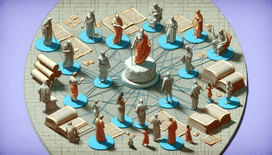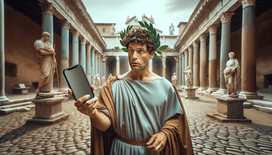Ah, the Titanic, an opulent floating behemoth synonymous with luxury, tragedy, and James Cameron's unparalleled ability to make us all sob into our popcorn. Launched with much fanfare on 10th April 1912, the ship was considered unsinkable until it, well, sunk. But, here's a thought: what if Captain Edward Smith and his merry crew had access to GPS technology? Would the Titanic have sailed into infamy or smoothly navigated to New York, merely known for its ice-resistant swagger?
The "Unsinkable" Opts for "Unstoppable"
Imagine it: the Titanic's bridge outfitted with a satellite navigation system, replete with a calming British voice reminiscent of a butler, "Turn starboard in 200 metres, and, might I say, my word, there's an iceberg ahead." Captain Smith, adorned not in his iconic naval cap but rather a Bluetooth earpiece, issues commands while sipping tea from WiFi-enabled smart crockery.
"Plot me a safe course, Jeeves!" he'd command, and the digital butler - in a crisp, Terry-approved accent - would swiftly avoid all hazards lurking in the North Atlantic night like a game of maritime Minesweeper.
A Safer Voyage: Dishing Measurements and Nautical Puns
With clear, concise coordinates, the Titanic could zig-zag around icy obstacles with all the grace of a prima ballerina in a life vest. GPS technology, my dear readers, is like Google Maps for seafaring folk – only without dubious detours through random Scottish lochs.
"Jeeves, recalculate and avoid hazardous routes!" Captain Smith might exclaim as the ship's navigation system chirps an efficient, "Certainly, Sir. Avoiding doom, doom, doom… recalculating…" All at once, Lady Luck feels superfluous, and Fate takes an unceremonious holiday.
No More Morse
Let's not forget how GPS would transform communication. In this alternate reality, the Titanic's wireless operators, Jack Phillips and Harold Bride, are enthusiasts of GPS-driven fitbits that measure stress and sat-nav that does all the unpleasant panic-induced sprints for you.
Instead of pumping out frantic telegrams to distant vessels or engaging in a manic game of Morse code SOS, they'd draft reassuring emails – all emoji-laden, natch – to awaiting loved ones. Imagine Jennifer in Southampton getting a gif of an iceberg that reads, "We gave it the slip! See you soon. 💪🚢"
180-Degree Change in Rescue Operations
Now, let’s not forget the role GPS would play if things had still veered iceberg-ly awry. In this case, it's the cavalry to the rescue, coordination between nearby ships being as seamless as a symphony. The Carpathia, the Celtic, and even the Californian would respond efficiently to virtual beacons, arriving in advance for a cordial lifeboat transfer. After all, there's no drama like drama that doesn’t involve preposterous adversity!
Legacy, or "Whole New Deck of Cards?"
It's fascinating to wonder - would the Titanic remain another unsinkable myth, a nautical whisper in history, or just another ship in maritime archives had GPS led its charge? Perhaps it would be celebrated not for its infamous demise but as a legend in oceanic navigation technology, with the odd GPS pun on deck. Naut here, naut there, but just right.
What do we conclude, dear curators of alternate realities? Technology might have spared Titanic from a chilly fate, but let it not be said that she avoided the icy embrace only to watch passers-by turn frosty at the lack of a grand narrative! In this version, Captain Smith and crew not only lived to tell their tale, but they also returned to Southampton to install GPS modules right across the White Star Line fleet. How very "future-proof" of them!
And thus unfolds the tale of how a little bit of sat-nav could have turned a massive maritime misstep into a mere footnote. Titanic, you crafty old iceberg-dodger, you!







